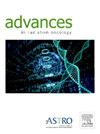Prospective Phase II Trial of Definitive Chemoradiation and Concurrent Nivolumab in Locally Advanced p16+ Oropharynx Cancer
IF 2.7
Q3 ONCOLOGY
引用次数: 0
Abstract
Purpose
We conducted a prospective, single-institution phase II trial to test the hypothesis that the addition of nivolumab to definitive chemoradiation would improve the progression-free survival (PFS) among patients with high-risk p16+ oropharyngeal squamous cell carcinoma (OPSCC).
Methods and Materials
Patients with previously-untreated locoregionally advanced, p16+ OPSCC (clinical T4/N3, matted lymph nodes, and/or retropharyngeal lymphadenopathy) were enrolled. Patients received a priming dose of nivolumab, concurrent nivolumab and chemoradiation (70 Gy to PTVhigh, 56 Gy to PTVlow, weekly carboplatin/paclitaxel), and 4 cycles of adjuvant nivolumab over 12 weeks. The primary endpoint was 2-year PFS compared to an institutional historic control of 68%. Exploratory endpoints included associations between survival and circulating tumor DNA kinetics during treatment and pretreatment/midtreatment 18F-fluorodeoxyglucose positron-emission tomography with computed tomography and magnetic resonance imaging metrics (gross tumor volume, low blood volume tumor subvolume, low apparent diffusion coefficient tumor subvolume, and metabolic tumor volume ≥50% of maximum standardized uptake value).
Results
Twenty-six patients were enrolled prior to an interim analysis; 65% cT4, 46% with matted nodes, with a median total gross tumor volume of 60 cc (range, 36-165). Estimated 2-year PFS was 65% (2-sided 90% CI, 46%-79%) and 2-year distant metastasis-free survival was 84% (66%-93%). The majority (69%) did not complete the full course of nivolumab because of toxicity, and 54% experienced grade ≥3 acute dysphagia. Statistical analyses showed that increasing values of imaging-defined primary tumor subvolumes were significant associated with inferior PFS (eg, midtreatment low apparent diffusion coefficient: HR, 5.61; P = .05) and distant metastasis-free survival (eg, pretreatment metabolic tumor volume ≥50% of maximum standardized uptake value: HR, 2.97; P = .05). Midtreatment circulating tumor DNA kinetics were not associated with survival endpoints.
Conclusions
Concurrent and adjuvant nivolumab did not improve PFS in locoregionally advanced Human papillomavirus+ OPSCC and was associated with significant toxicity. Physiological magnetic resonance imaging and 18F-fluorodeoxyglucose positron-emission tomography with computed tomography imaging markers are potential biomarkers to guide future therapy escalation strategies in high-risk oropharynx cancer.
局部晚期p16+口咽癌的确定性放化疗和并发纳武单抗的前瞻性II期试验
目的:我们进行了一项前瞻性、单机构II期试验,以验证在最终放化疗中添加纳武单抗可以改善高风险p16+口咽鳞状细胞癌(OPSCC)患者的无进展生存期(PFS)的假设。方法和材料纳入先前未经治疗的局部区域晚期p16+ OPSCC(临床T4/N3,淋巴结结团和/或咽后淋巴结病)患者。患者接受纳武单抗的起始剂量,同时接受纳武单抗和放化疗(70 Gy至PTVhigh, 56 Gy至PTVlow,卡铂/紫杉醇每周一次),并在12周内接受4个周期的纳武单抗辅助治疗。主要终点是2年PFS,而机构历史控制率为68%。探索性终点包括治疗期间和治疗前/治疗中期生存与循环肿瘤DNA动力学之间的关系。18f -氟脱氧葡萄糖正电子发射断层扫描与计算机断层扫描和磁共振成像指标(肿瘤总体积、低血容量肿瘤亚体积、低表观扩散系数肿瘤亚体积和代谢肿瘤体积≥最大标准化摄取值的50%)。结果26例患者在中期分析前入组;cT4占65%,结簇占46%,肿瘤总体积中位数为60cc(范围36-165)。估计2年PFS为65%(双侧90% CI, 46%-79%), 2年远处无转移生存率为84%(66%-93%)。由于毒性,大多数(69%)患者没有完成纳武单抗的整个疗程,54%患者出现≥3级急性吞咽困难。统计分析显示,影像学定义的原发性肿瘤亚体积值的增加与较差的PFS显著相关(例如,治疗中期低表观扩散系数:HR, 5.61;P = 0.05)和远端无转移生存(例如,预处理代谢肿瘤体积≥50%的最大标准化摄取值:HR, 2.97;P = 0.05)。治疗中期循环肿瘤DNA动力学与生存终点无关。结论并发和辅助nivolumab不能改善局部进展期人乳头瘤病毒+ OPSCC患者的PFS,并伴有明显的毒性。生理磁共振成像和18f -氟脱氧葡萄糖正电子发射断层扫描与计算机断层扫描成像标记物是指导未来高危口咽癌治疗升级策略的潜在生物标志物。
本文章由计算机程序翻译,如有差异,请以英文原文为准。
求助全文
约1分钟内获得全文
求助全文
来源期刊

Advances in Radiation Oncology
Medicine-Radiology, Nuclear Medicine and Imaging
CiteScore
4.60
自引率
4.30%
发文量
208
审稿时长
98 days
期刊介绍:
The purpose of Advances is to provide information for clinicians who use radiation therapy by publishing: Clinical trial reports and reanalyses. Basic science original reports. Manuscripts examining health services research, comparative and cost effectiveness research, and systematic reviews. Case reports documenting unusual problems and solutions. High quality multi and single institutional series, as well as other novel retrospective hypothesis generating series. Timely critical reviews on important topics in radiation oncology, such as side effects. Articles reporting the natural history of disease and patterns of failure, particularly as they relate to treatment volume delineation. Articles on safety and quality in radiation therapy. Essays on clinical experience. Articles on practice transformation in radiation oncology, in particular: Aspects of health policy that may impact the future practice of radiation oncology. How information technology, such as data analytics and systems innovations, will change radiation oncology practice. Articles on imaging as they relate to radiation therapy treatment.
 求助内容:
求助内容: 应助结果提醒方式:
应助结果提醒方式:


